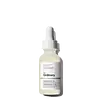What's inside
What's inside
 Key Ingredients
Key Ingredients

 Benefits
Benefits

 Concerns
Concerns

No concerns
 Ingredients Side-by-side
Ingredients Side-by-side

Water
Skin ConditioningSodium Hyaluronate
HumectantPropanediol
SolventPentylene Glycol
Skin ConditioningHydrolyzed Hyaluronic Acid
HumectantSodium Hyaluronate Crosspolymer
HumectantPhospholipids
Skin ConditioningSphingolipids
EmollientPanthenol
Skin ConditioningAhnfeltiopsis Concinna Extract
Skin ConditioningGlycerin
HumectantPolysorbate 20
EmulsifyingCitric Acid
BufferingSodium Citrate
BufferingP-Anisic Acid
MaskingTocopherol
AntioxidantTrisodium Ethylenediamine Disuccinate
Caprylyl Glycol
EmollientEthoxydiglycol
HumectantEthylhexylglycerin
Skin ConditioningHexylene Glycol
EmulsifyingPhenoxyethanol
PreservativeChlorphenesin
AntimicrobialWater, Sodium Hyaluronate, Propanediol, Pentylene Glycol, Hydrolyzed Hyaluronic Acid, Sodium Hyaluronate Crosspolymer, Phospholipids, Sphingolipids, Panthenol, Ahnfeltiopsis Concinna Extract, Glycerin, Polysorbate 20, Citric Acid, Sodium Citrate, P-Anisic Acid, Tocopherol, Trisodium Ethylenediamine Disuccinate, Caprylyl Glycol, Ethoxydiglycol, Ethylhexylglycerin, Hexylene Glycol, Phenoxyethanol, Chlorphenesin
Sodium Hyaluronate
HumectantNiacinamide
SmoothingButylene Glycol
HumectantAloe Barbadensis Leaf Extract
EmollientPanthenol
Skin ConditioningDipotassium Glycyrrhizate
HumectantCentella Asiatica Extract
CleansingPolygonum Cuspidatum Root Extract
AntioxidantScutellaria Baicalensis Root Extract
AstringentCamellia Sinensis Leaf Extract
AntimicrobialGlycyrrhiza Glabra Root Extract
BleachingChamomilla Recutita Flower Extract
MaskingRosmarinus Officinalis Leaf Extract
AntimicrobialChrysanthellum Indicum Extract
Skin ConditioningAdansonia Digitata Seed Extract
Skin ConditioningRoyal Jelly Extract
Skin ConditioningHoney Extract
HumectantYeast Extract
Skin ConditioningPaullinia Cupana Seed Extract
Skin ConditioningOlea Europaea Fruit Extract
BleachingJuniperus Communis Fruit Extract
PerfumingHouttuynia Cordata Extract
Skin ConditioningPsidium Guajava Leaf Extract
AstringentDisodium EDTA
Carbomer
Emulsion StabilisingCeramide AP
Skin Conditioning1,2-Hexanediol
Skin ConditioningCaprylyl Glycol
EmollientIllicium Verum Fruit Extract
PerfumingAdenosine
Skin ConditioningPEG-60 Hydrogenated Castor Oil
EmulsifyingBorago Officinalis Seed Oil
EmollientPrunus Amygdalus Dulcis Oil
Skin ConditioningMacadamia Integrifolia Seed Oil
Skin ConditioningHelianthus Annuus Seed Oil
EmollientBrassica Campestris Seed Oil
Skin ConditioningTriethanolamine
BufferingPhenoxyethanol
PreservativeParfum
MaskingSodium Hyaluronate, Niacinamide, Butylene Glycol, Aloe Barbadensis Leaf Extract, Panthenol, Dipotassium Glycyrrhizate, Centella Asiatica Extract, Polygonum Cuspidatum Root Extract, Scutellaria Baicalensis Root Extract, Camellia Sinensis Leaf Extract, Glycyrrhiza Glabra Root Extract, Chamomilla Recutita Flower Extract, Rosmarinus Officinalis Leaf Extract, Chrysanthellum Indicum Extract, Adansonia Digitata Seed Extract, Royal Jelly Extract, Honey Extract, Yeast Extract, Paullinia Cupana Seed Extract, Olea Europaea Fruit Extract, Juniperus Communis Fruit Extract, Houttuynia Cordata Extract, Psidium Guajava Leaf Extract, Disodium EDTA, Carbomer, Ceramide AP, 1,2-Hexanediol, Caprylyl Glycol, Illicium Verum Fruit Extract, Adenosine, PEG-60 Hydrogenated Castor Oil, Borago Officinalis Seed Oil, Prunus Amygdalus Dulcis Oil, Macadamia Integrifolia Seed Oil, Helianthus Annuus Seed Oil, Brassica Campestris Seed Oil, Triethanolamine, Phenoxyethanol, Parfum
 Reviews
Reviews

Ingredients Explained
These ingredients are found in both products.
Ingredients higher up in an ingredient list are typically present in a larger amount.
Caprylyl Glycol is a humectant and emollient, meaning it attracts and preserves moisture.
It is a common ingredient in many products, especially those designed to hydrate skin. The primary benefits are retaining moisture, skin softening, and promoting a healthy skin barrier.
Though Caprylyl Glycol is an alcohol derived from fatty acids, it is not the kind that can dry out skin.
This ingredient is also used as a preservative to extend the life of products. It has slight antimicrobial properties.
Learn more about Caprylyl GlycolPanthenol is a common ingredient that helps hydrate and soothe the skin. It is found naturally in our skin and hair.
There are two forms of panthenol: D and L.
D-panthenol is also known as dexpanthenol. Most cosmetics use dexpanthenol or a mixture of D and L-panthenol.
Panthenol is famous due to its ability to go deeper into the skin's layers. Using this ingredient has numerous pros (and no cons):
Like hyaluronic acid, panthenol is a humectant. Humectants are able to bind and hold large amounts of water to keep skin hydrated.
This ingredient works well for wound healing. It works by increasing tissue in the wound and helps close open wounds.
Once oxidized, panthenol converts to pantothenic acid. Panthothenic acid is found in all living cells.
This ingredient is also referred to as pro-vitamin B5.
Learn more about PanthenolPhenoxyethanol is a preservative that has germicide, antimicrobial, and aromatic properties. Studies show that phenoxyethanol can prevent microbial growth. By itself, it has a scent that is similar to that of a rose.
It's often used in formulations along with Caprylyl Glycol to preserve the shelf life of products.
Sodium Hyaluronate is hyaluronic acid's salt form. It is commonly derived from the sodium salt of hyaluronic acid.
Like hyaluronic acid, it is great at holding water and acts as a humectant. This makes it a great skin hydrating ingredient.
Sodium Hyaluronate is naturally occurring in our bodies and is mostly found in eye fluid and joints.
These are some other common types of Hyaluronic Acid:
Learn more about Sodium Hyaluronate